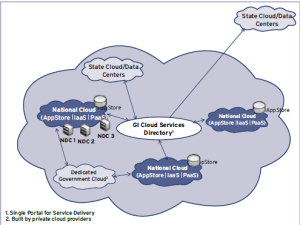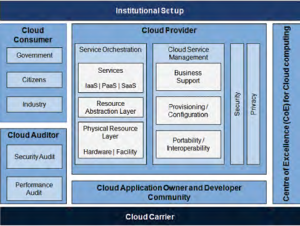MeghRaj Government’s GI Cloud initiative
India, with its vibrant IT
Industry and accelerated IT adoption in government, is uniquely
positioned to benefit from cloud computing
 Renu Budhiraja, Sr Director & HOD State Data Centers, Department of Electronics & IT (DeitY), Government of India
Renu Budhiraja, Sr Director & HOD State Data Centers, Department of Electronics & IT (DeitY), Government of India
 Renu Budhiraja, Sr Director & HOD State Data Centers, Department of Electronics & IT (DeitY), Government of India
Renu Budhiraja, Sr Director & HOD State Data Centers, Department of Electronics & IT (DeitY), Government of India
Cloud computing has been identified as
one of the thrust areas in the proposed National IT Policy from
Government of India. This is likely to unleash new growth opportunities
for Indian IT Industry and also bring innovation in the way IT solutions
and services are delivered.
To utilise and harness the benefits of Cloud,the Department of Electronics and Information Technology (DeitY) of Government of India has embarked upon an ambitious programme – ‘GI Cloud’, also coined as ‘MeghRaj’. In order to drive this initiative, a Task Force was constituted by the Department of Electronics and Information Technology (DeitY) with the objective to bring out the strategic direction and implementation roadmap of GI Cloud leveraging the existing or new infrastructure.
The GI Cloud vision, policy and the respective policy principles are as mentioned below:To utilise and harness the benefits of Cloud,the Department of Electronics and Information Technology (DeitY) of Government of India has embarked upon an ambitious programme – ‘GI Cloud’, also coined as ‘MeghRaj’. In order to drive this initiative, a Task Force was constituted by the Department of Electronics and Information Technology (DeitY) with the objective to bring out the strategic direction and implementation roadmap of GI Cloud leveraging the existing or new infrastructure.
GI Cloud Vision
The GI Cloud vision is ‘To accelerate delivery of e-services provided by the government and to optimise ICT spending of the government’.
The GI Cloud vision is ‘To accelerate delivery of e-services provided by the government and to optimise ICT spending of the government’.
GI Cloud Policy
The GI Cloud policy states, Government departments at the centre and states to first evaluate the option of using the GI Cloud for implementation of all new projects funded by the government. Existing applications, services and projects be evaluated to assess whether they should migrate to the GI Cloud’.
The GI Cloud policy states, Government departments at the centre and states to first evaluate the option of using the GI Cloud for implementation of all new projects funded by the government. Existing applications, services and projects be evaluated to assess whether they should migrate to the GI Cloud’.
GI Cloud Policy Principles
The GI Cloud policy principles as defined in the report are:
The GI Cloud policy principles as defined in the report are:
- All government clouds to follow the standards and guidelines set by Government of India
- At the time of conceptualisation of any new Mission Mode Project (MMP) or other government project the existing services (IaaS, PaaS, SaaS) of GI Cloud to be evaluated first for usage
- All new applications to be cloud ready
Overview of GI Cloud Implementation and Adoption Roadmap
The ‘GI Cloud Adoption and Implementation Roadmap’ provides details of GI Cloud implementation aspects. It defines the architectural vision, various components, eco-system and the institutional mechanism of GI Cloud. It also introduces the business and self-sustaining model and covers the capacity and capability building aspects required for GI Cloud. Finally it provides the steps for implementation of GI Cloud.
Features of e-Gov App Store
|
Road Map
|
 GI Cloud Architecture
GI Cloud ArchitectureThe architectural vision of GI Cloud centres on a set of discrete cloud computing environments spread across multiple locations, built on existing or new (augmented) infrastructure, following a set of common protocols, guidelines and standards issued by the Government of India. The GI Cloud services will be published through a GI Cloud Services Directory.
One of the major considerations made while developing the architecture vision has been consideration for the investments that have already been made by the government on building infrastructure both at the national as well as state levels, for example, data centres at the national and state levels, the network backbones available through SWAN, NKN, NICNET and the middleware gateways e.g. NSDG, SSDG.
The GI Cloud environment has been depicted in the figure below.
GI Cloud Services
The GI Cloud will be equipped to provide cloud services, i.e. IaaS, PaaS and SaaS. However, the services provided by GI Cloud are different from the end-user services like services delivered through various MMPs like e-District, Passport, eSeva Project, MCA21 and Income Tax, and other national or state projects like UIDAI. An indicative list of cloud-based services include:
The GI Cloud will be equipped to provide cloud services, i.e. IaaS, PaaS and SaaS. However, the services provided by GI Cloud are different from the end-user services like services delivered through various MMPs like e-District, Passport, eSeva Project, MCA21 and Income Tax, and other national or state projects like UIDAI. An indicative list of cloud-based services include:
Infrastructure-as-a-service (IaaS):
- Compute as a service
- Storage as a service
- Network as a service
- Disaster recovery as a service
- Backup as a service
- Virtual desktop solutions
- Infrastructure for application development and testing
Platform-as-a-service (PaaS):
- Platform for application, portal development and testing
- Platform for application or portal hosting
- Database as a service
- Collaboration platforms
Software-as-a-service (SaaS):
- Email as a service
- Productivity suites (as a service)
- ERP as a service
- BI and analytics as a service
- Security as a service
- Common central services like payment gateway, mobile gateway, PKI, etc as a serviceNational eGov AppStore

National egovernence App store
One of the major components of GI Cloud includes establishing
National eGov AppStores at the National Clouds. The eGov AppStore
aims to be a National level common repository and market place of
productized applications and components that can be used by various
government agencies/departments at Centre and States, with the vision to
accelerate delivery of e-services. The pilot launch was held on 31st
May 2013 by MOC&IT with 20 applications (apps.gov.in).
GI Cloud Eco-System
The figure below depicts GI Cloud eco-system
The figure below depicts GI Cloud eco-system
Formulation of the GI Cloud Strategy
and adoption roadmap are one of the primary steps that will facilitate
large scale adoption of cloud by government. DeitY will now focus on
the implementation aspects of GI Cloud.





